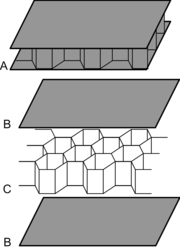From Wikipedia, the free encyclopedia
A sandwich structured composite is a special class of composite materials that is fabricated by attaching two thin but stiff skins to a lightweight but thick core. The core material is normally low strength material, but its higher thickness provides the sandwich composite with high bending stiffness with overall low density.
Diagram of an assembled composite sandwich (A), and its constituent face sheets or skins (B) and honeycomb core (C) (alternately: foam core)
Open and closed cell structured foam, balsa wood and syntactic foam, and composite honeycomb are commonly used core materials. Glass or carbon fiber reinforced laminates are widely used as skin materials. Sheet metal is also used as skin materials in some cases. The 1940 de Havilland Mosquito was built with sandwich composites, the balsa-wood core had on both sides plywood as the skin.[1]
Metal composite material (MCM) is a type of sandwich formed from two thin skins of metal bonded to a plastic core in a continuous process under controlled pressure, heat, and tension.[2]
Recycled paper is also now being used over a closed-cell recycled craft honeycomb core, creating a lightweight, strong and fully repulpable composite board. This material is being used for applications including point-of-purchase displays, bulkheads, recyclable office furniture, exhibition stands and wall dividers.
To fix different panels, among other solutions, are normally use a transition zone, which is a gradual reduction of the core height, until the two fiber skins are in touch. In this place, the fixation can be made by means of bolts, rivets or adhesive.

